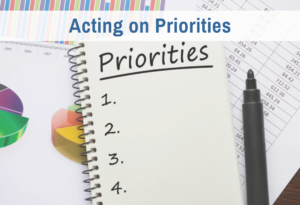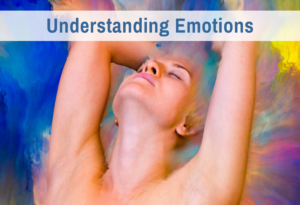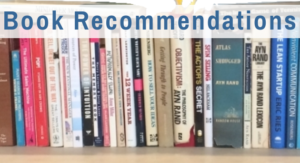I was recently asked to explain the difference between “emotional presence” and “self-esteem.”
Emotional presence
“Emotional presence” is an intense awareness of your values and their importance to you at the moment. You get it, not just from identifying your emotions, but from experiencing your love, grief, desire, and/or fear as you contemplate the deep rational value that underlies the emotion.
Let me concretize what I mean with a story. Some years ago, I was very nervous before giving a speech. I had not worked out a full script, so I knew I would need to ad lib. I also knew the nervousness would get in the way of extemporaneous speaking. So I paused to introspect the fear all the way down to what value I was after most.
In writing a script, my top goal would be clarity. But in this case, what I wanted most was a genuine connection with the audience so they could take in what I was saying as well as possible, even though I would not be as clear as sometimes. Once I realized this, I didn’t stop feeling fear per se, but the experience of fear shifted to be the exciting frisson around the edges that is associated with risk-taking. That frisson added an intensity to the desire to connect with my audience that I had stirred by my process. Together, these feelings created a sense of aliveness in me, which put me in an optimal state for an extemporaneous performance. I was emotionally present. I’ve been told it was one of my best presentations ever.
Self-esteem
“Self-esteem” is “the conviction [you] are able to live and worthy of living.” (Ayn Rand’s words.) She called it one of the “supreme and ruling values.” It’s not to be confused with self-congratulation or self-satisfaction. Self-esteem needs to be explicit when you face setbacks and failures. Then, reminding yourself of this basic conviction provides an emotional backstop in a difficult time. It stops the pain from going down “all the way.”
For example, I have been working on developing a better system for managing my commitments. As a result, I am trying out new processes — some of which work, and some of which don’t. The morning after a failure, I start the day in a crabby mood because I’m thinking about that failure. To pick myself up and get going on something productive, I often need to remind myself of the bigger picture. I’m a good person who had a setback. Experimental failure is part of the process of figuring out what works. It does not reflect on me per se. I will figure out what works eventually.
To reorient this way, I am relying on the fact that I do believe that this concrete failure does not reflect on me as a person per se, and that this whole process of learning is a reflection of my commitment to morality. I use this general conclusion about myself to activate a more constructive state for moving forward.
The differences between them
At first glance, emotional presence and self-esteem are disparate phenomena.
Emotional presence is a temporary condition. You can become emotionally present by design, as I did, but you can also become emotionally present by chance. For example, during a heart-to-heart conversation with someone you love, you can sometimes find yourself in that alive state. I’ve experienced it with a bit of surprise when contemplating nature. “Emotionally present” is a name for an experience that we all have when conceptual awareness and emotional awareness are in intense harmony. You have a clear purpose and intense affect, without conflict.
But emotional presence is ephemeral. It lasts only as long as that state of awareness lasts. If you become distracted, you fall out of that state. If you trigger internal conflict, you fall out of it. If you lose your place, you fall out of it.
In contrast, self-esteem is an enduring conviction. It is integral to your personality and your character. The conclusion that you are able to live and worthy of living is established as a given at some point. This doesn’t mean you never again feel self-doubt. But when you do feel it, you have the means to remind yourself, persuasively, that the self-doubt is based on a mistake.
You might say to yourself, “What a jerk I am!” but at a deeper level, you don’t really believe that you’re a jerk. When you’re doubting or criticizing yourself, you can recall the facts that put the present difficulty into perspective and activate your true sense of self. No matter what the situation, you can always fall back on your conviction that you are able to live and worthy of living. You may need to learn a process to do so quickly and easily, but the basic conclusion is there in the background, available to be tapped.
The relationship between them
Although they are disparate phenomena — analogous to the relationship of velocity and horsepower — there is something that relates them.
If you are in some emotional trouble, or inner conflict, or a state of detachment, you need to become emotionally present to function effectively. If that is difficult to do through some other process, you can become emotionally present if you activate a self-esteem context, but that is not the usual go-to.
Usually the fastest and easiest way forward when you’re in any kind of emotionally difficult state is to give your contrary motivation a fair hearing. I teach many tactics for doing this in the Thinking Lab, tactics that take from 3 minutes to 3 hours. I recommend you choose the tactic based on the severity of the distress and how much disruption it’s causing. If you are so upset about something that you have lost a day of work, a 3-hour tactic makes sense. If you are simply having trouble settling down to work, a 3-minute tactic makes sense.
All of these tactics have one thing in common: they help you understand the particular situation you are in. They help you identify concrete values you care about, including one you can go after now. They always help you find a constructive step forward from where you are now. They leave you with full awareness of both the value you are going for (connection in the presentation example) and any value that you are mourning (clarity in that same example).
But no tactic is fail-safe. Every such process requires some creative problem-solving to figure out a concrete way forward. Sometimes you do not have the knowledge or skill to figure that out in a timely way. In these cases, activating self-esteem can make all of the difference. It doesn’t solve any problem, it doesn’t help you figure out a step forward, but it does get you back to being value-oriented and emotionally present.
Activating a self-esteem context
When you activate a self-esteem context, the value that you become emotionally present with is the value of you to you. There are several ways to do this. I teach a process that is particularly helpful when you are highly self-critical. It is summed up in four catchy sentences:
Have your own back:
-
-
- Don’t run away.
- Don’t melt down.
- Don’t stab yourself in the back.
-
This little formula grabs your attention and reminds you that you have a choice. You do not need to fall into the default action (which is ultimately self-destructive) such as avoiding the problem, throwing a conniption fit, acting out, overeating, overdrinking, or any other bad habit that you know is not good for you.
And it does it in the name of “have your own back.” It reminds you that you are your own backstop.
This is something you can always do. I recommend you do it on a 3-minute walk — to get yourself calmed down and reoriented. By the end of the 3 minutes, you are in a different mental state and can assess the situation more neutrally and decide what you’re going to do.
No one-size-fits-all solution
Sometimes people think there should be a tactic that works whenever you are in distress. But this is not the case. Whether a tactic works depends on many factors, including your knowledge and experience with the tactic, your ability to introspect, and your understanding of the situation you face. You need to know a range of tactics that you can apply in different situations, depending on what exactly is going on. And you need a conceptual understanding of what the tactics do to help you easily figure out which one to use. This last is what I hope I’ve added to with this article.








0 Comments